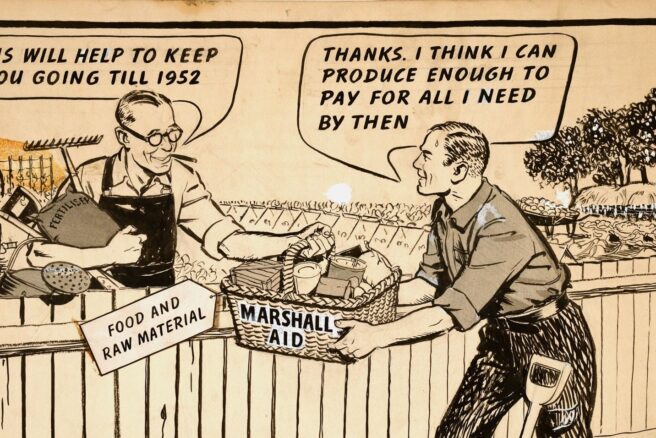The economic aid after World War II known as the Marshall Plan can presently serve as an example of how an economic crisis can be fought against not only relying on financial or monetary aid but also with an effective push for policy-reform.
This article offers a brief literature review of the Marshall Plan (1948-1951), analyzes its problematics, comprehends the problems of the time, evaluates its role in driving faster economic growth in post-World War II Europe, and consequently assesses its importance for the present day and the present Corona crisis. What lessons can the Marshall Plan teach us today?
The Marshall Plan as post-war policy
The 1930s were marked by instability with periods of both anemic economic growth and even decline, greater animosity between European powers, and the rise of fascism. According to Milton Friedman, this economic decline was mostly due to the mistakes of the United States’ Federal Reserve Bank. While war-time economics have stimulating potential, the enormous destruction of World War II left many European economies in ruins.
The Marshall Plan was pursued after World War II as economic aid, but it also included a necessary economic policy reform that European nations had been reluctant to adopt.
What lessons can the Marshall Plan teach us today?
The role of the Marshall Plan has been a topic of great importance for economists and political scientists as its nature had been usually understood as a straight-forward financial aid for a war-devastated Europe. The generally stable growth that followed in Western Europe in the 30 years after World War II has generally been credited to both the Marshall Plan and the Social-Democratic and Christian Democrat governments and the policies that ensued. However, this interpretation may be too simplistic.
The Marshall Plan: what, when, who and why?
The Marshall Plan’s name was derived from the soldier, statesman, and Nobel Prize winner George Marshall (1880-1959). In its entirety, the Plan encompassed 13 billion dollars (at 1948 values) in economic aid and was directed to European countries that had closer ties with the United States and were more politically open to free markets and trade.
Many of these nations also shared relatively strong anti-communist sentiments, despite also being highly protectionist at the time (as was the case of France). The anti-communist policy agenda behind the Marshall Plan was also meant to limit the influence of the Soviet Union and Communist parties in Western Europe. Aid was given to Western Germany (1448 million dollars), UK (3297 million dollars), France (2296 million dollars), Belgium, the Netherlands, Luxembourg, and 10 other nations, with varying emphasis.
The Marshall Plan was pursued after World War II as economic aid, but it also included a necessary economic policy reform that European nations had been reluctant to adopt.
Consequently, the USSR blocked this aid to most of Eastern Europe and would later develop the Molotov plan which was to be applied in Central and Eastern European nations such as Poland, Czechoslovakia, Hungary, Romania, and Bulgaria.
Diverging roads to economic recovery in Europe
One of the most important and cited academics who studied the Marshall Plan was Professor Alan Milward. According to Milward, the economic recovery in Western Europe could have happened with or without the Marshall Plan, although perhaps it wouldn’t have been as fast. It would have eventually taken a slightly longer period of time for such growth to be seen.
Milward states that an important factor that initiated the growth of Western and Central Europe was West Germany’s intent on increasing its productivity, facilitating or liberalizing both imports and exports with low tariffs, thus helping expert manufacturers in neighboring countries. This also provided the opportunity to replace American export products as considerable demand for West German industry production was increasingly sought in Europe.
British protectionism at the wake of the economic troubles at the time and the UK’s close political partnership with the USA was another reason for West Germany to search for intra-European trade (eventually leading to the Treaty of Rome, the initial treaty that created the European Economic Community and would later lead to the European Union). Milward contends that West Germany would have followed these policies whether it would have received aid under the Marshall Plan or not.
Professor Frances Lynch contends that while the United Kingdom was one of the military and political winners of the Second World War, it wasn’t able to use that victory for greater economic resurgence as compared to its Western European partners – despite the aid of the Marshall Plan. The military victories of the war were followed by only modest, short-term economic ones during peacetime, to the point of them nearly being insignificant.
While the United Kingdom was one of the military and political winners of the Second World War, it wasn’t able to use that victory for greater economic resurgence as compared to its Western European partners – despite the aid of the Marshall Plan.
British interests were mostly centered on its special partnership with the United States, the ability to create a nuclear arsenal, to make its capital a financial center in Europe – and elsewhere – despite maintaining some protectionist policies at home. These economic policies aimed to continue its world influence in the context of decolonization. This meant strengthening trading routes and commerce and developing its own version of an international tariff system, all the while trying to expand and maintain the reach and scope of its armed forces.
The “one-world policy”, as it was named, was viewed as Britain’s attempt to keep a dominant role, a leading character in the relations with the USA and the Soviet Union and with Western Europe. Most of these objectives were largely unaccomplished within a few years as the Western European economies would start to outgrow the UK and a bipolar world of the Cold War would come to dominate the world stage.
The Marshall Plan as a political tool for reform
Bradford De Long and Barry Eichengreen have a slightly different interpretation from Milward’s, as they stated that the Marshall Plan did play an important role in Western Europe’s recovery, but more for its political influence and not as much in its financial aid role. They state that these economies would little by little start to expand and eliminate trade barriers between its members, prioritizing free markets, less regulation, and balanced budgets, among other macro-economic measures.
In the United States’ point of view of the time, the relatively open market that served as the basis for its economic growth was to be replicated in Western Europe after World War II. However, following the economic crash of 1929, European economies were not that open for economic change – certainly not in the direction of free markets. The Marshall Plan sought for a return of these goals to European economic policy: in 1948, for example, a parcel of the Marshall Plan funding had been given to France with a demand for the French government to balance its budget and deregulate its economy.
The Marshall Plan did play an important role in Western Europe’s recovery, but more for its political influence and not as much in its financial aid role.
Indeed, according to Long and Eichengreen, about 83% of Marshall aid was used on imports of various products, industrial commodities, and agricultural products. This would also greatly benefit the largest producer of manufactured goods for Western Europe at the time: the United States. Only about 17% was used for machinery, transports or others. The Marshall Plan would thus provide more money for necessary and largely freer imports and greater intra-European trade and the injection of necessary capital movement.
The Marshall Plan: the foundation for a common European economy?
While France was focused on a primarily European community as its economic foundation, (aside from its colonial holdings) without the Marshall Plan, the French road to economic recovery might have been very different. The Marshall Plan was, therefore, not only an important economic aid but it was also a political device for reform in Western Europe. It presented a facilitated solution for the countries’ treasuries as a structural reform plan, rather than simple aid.
The Marshall Plan was also strongly tied with the Bretton Woods system as another important global monetary and financial transformation. The Marshall Plan was, therefore, a facilitator for economic growth but not an initiator: it represented only 3% of the national incomes of the states that received it. Social programs were at the time struggling for more revenues at the same time as inflationary policies and budget deficits were still a risk.
Aid is important but reform is much more significant.
Therefore, although the United States’ direct economic role in the European recovery is still debatable, as Milward and other authors have shown, the Marshall Plan should be understood in a context where the United States were ensuring the political and military safety and stability in Western Europe, without which many of these advancements would perhaps not have been possible.
Consequently, the execution of American foreign policy (whether politically or economically) can indeed be considered as having a predominantly positive effect on the evolution of later European integration.
Lessons from the Marshall Plan for the COVID-19 pandemic
The financial aid provided by the Marshall Plan was more important due to its economically reformative stance, rather than due to its purely material financial scope. The reformative stance of the Marshall Plan facilitated expanding free markets and increasing productivity for European – particularly West-German – imports and exports. This can be seen to have fed into the forces that also led to the creation of the European Economic Community (and later the European Union).
Despite the differences between post-war Europe and the present Corona crisis, historical occurrences can be revisited, and old lessons learned anew: The Corona crisis is also a global economic crisis. The Marshall Plan can serve as an example of how a crisis can be fought not only relying on financial or monetary aid but also with an effective push for policy-reform.
Both the lessons of the Marshall Plan and the Euro crisis must serve as important reminders on how to tackle the Corona crisis today.
The fact that the present American presidency is focused on greater protectionism led to European crisis relief efforts this time being handled by primarily the ECB and the European Commission. The ECB has coupled a vast monetary mass plan with low interest rates and controlled inflation, while the Commission has proposed an extra intergovernmental budget (2021-2027).
It consists of approximately €1.8 trillion, in both hand-outs and loans, designed to facilitate the financial recovery of states and companies, all the while grappling with the hard task of assuring medical and health stability of the population (together with states).
The 2008 financial crisis led to great divisions within the EU, high unemployment, and an economic recession. However, low inflation levels in the Eurozone were maintained (despite a much greater monetary mass) and economic recovery was attained for some years. Both the lessons of the Marshall Plan and the Euro crisis must serve as important reminders on how to tackle the Corona crisis today. Aid is important but reform is much more significant.
Luís Sargento Freitas received his doctorate from the University of Jyväskylä in Finland in 2018 and is in the early phases of his post-doctoral project.





